Common menu bar links
Institutional links
Diseases & Conditions
Health & Safety
Research & Statistics
Agency Information
Search Box
E-mail this page
Welcome to the first issue of the "Update: Vaccine-Preventable Diseases"
Volume 5, Number 3, October 1997

Child with pertussis - coughing spasms with a
"whooping"
sound that follows the cough are typical.
Courtesy of the World Health Organization
and the Immunization Action Coalition (USA)
Current News
Update on the Use of Acellular Pertussis Vaccines for Infant Immunization
Theresa Tam, Field Epidemiologist, Division of Immunization, LCDC, Ottawa
Acellular pertussis vaccines containing purified antigens of Bordetella pertussis are efficacious and remarkably free of adverse effects when given to infants as a primary series(1). Recently, combination vaccines incorporating acellular pertussis vaccine antigens were licensed for use in infants in Canada. A statement on pertussis vaccine published by the National Advisory Committee on Immunization in July 1997 gives the background information on the currently licensed products and the recommendations for their use (1). Table 1 summarizes the manufacturers, product names, constituents, and indications for licensed whole-cell and acellular pertussis vaccines.
|
Table 1 |
|||||||
|
Manufacturer |
Product |
Constituents |
Indications |
Manufacturer |
Product |
Constituents |
Indications |
|
Acellular Pertussis Vaccines |
Whole-Cell Pertussis Vaccines |
||||||
|
Pasteur Mérieux Connaught Canada |
TRIPA- |
diphtheria |
primary
and booster |
Pasteur Mérieux Connaught Canada |
Pertussis
Vaccine (P) |
pertussis
(4 mouse protective units [MPU]) |
primary
and booster |
|
QUADRA- |
same as
TRIPACELTM plus |
primary
and booster |
DPT-Polio
Adsorbed |
same as
DPT |
primary
and booster |
||
|
PENTA- |
same as
QUADRA- |
primary
and booster |
DPT-Hib |
same as
DPT |
primary and booster |
||
|
Wyeth- |
Acel-PTM |
pertussis
antigens |
primary
and booster |
PENTATM |
same as
DPT-Polio |
primary
and booster |
|
|
ACEL- |
same as
Acel-PTM |
primary
and booster |
Wyeth- |
TRI- |
diphtheria
(12.5 Lf) |
primary
and booster |
|
|
SmithKline Beecham Pharma Inc. |
InfanrixTM |
diphtheria
(30 IU) |
primary
and booster |
TETRA |
same
as |
primary
and booster |
|
|
Source: National Advisory Committee on Immunization. Statement on pertussis vaccine. CCDR 1997;23(ACS-3):11. |
|||||||
Preliminary results of a recent survey by the Laboratory Centre for Disease Control show that Ontario, Alberta, the Northwest Territories, Prince Edward Island, and Newfoundland have already introduced the PENTACELTM vaccine to their infant immunization schedules. Quebec will be introducing PENTACELTM vaccine to their infant immunization schedule later this year. PENTACELTM (DTaP-Polio-Hib) is the only licensed acellular pertussis vaccine combining diphtheria and tetanus toxoids adsorbed, inactivated polio vaccine and Hib conjugate vaccine, allowing for simplified vaccine administration.
Reference
1. National Advisory Committee on Immunization. Statement on pertussis vaccine. CCDR 1997;23(ACS-3):1-16.
[Table of Contents]Barefoot in the Park ?
Community-acquired Needlestick Injuries: Risk Assessment and Post-exposure Response*
Robert Slinger, Field Epidemiologist, Division of Bloodborne Pathogens, LCDC, Ottawa
There have been recent guidelines in Canada(1) and the United States(2) related to the exposure of health-care workers to bloodborne pathogens through occupational needlestick injuries. However, the issues related to community-acquired needlestick injuries (CANSIs) are generally not dealt with explicitly in these protocols. Although there is very little scientific information available to help guide the health practitioner when faced with such injuries, the current state of knowledge and opinions of various expert groups are reviewed below. While the number of CANSIs encountered in most hospitals is not large, the anxiety provoked in patients and staff is great. Advance preparation with creation of protocols for dealing with CANSIs will lead to effective and timely management of these injuries.
Epidemiology
Canadian data on needlestick injuries in children from the Canadian Hospitals Injury Reporting and Prevention Program (CHIRPP) database, collected from 10 pediatric hospitals between 1991 and 1996, shows 124 injuries over this 6-year period. Fifty-four percent of these occurred in the 5- to 9-year age group (Dr. Susan Mackenzie, Bureau of Reproductive and Child Health, LCDC, Ottawa: personal communication, 1997). Data on subsequent infection with bloodborne viruses are not available. The UK Public Health Laboratory Service Communicable Disease Surveillance Centre reviewed data from patients given hepatitis B immune globulin (HBIG) in England and Wales and noted 958 out-of-hospital needlestick injuries over a 3-year period(3). Of the incidents with the location recorded, the most common site was ìin the streetî followed in order by ìfrom contact with rubbishî, ìin the parkî, and ìon the beachî. Over a 5-year period, an analysis in Edinburgh, Scotland showed that 67 children presented with CANSIs at an urban pediatric hospital(4). Of note, 10 of those children were injured while pretending to be injection drug users (IDUs). In another report, 52 cases presented at a children's hospital in Dublin, Ireland over a 16-month period; the median age of the children was 7.4 years(5). Although hepatitis B virus (HBV) vaccine was initiated in all cases, the vaccine series was sometimes not completed, highlighting the need for standard management protocols. The author is not aware of any documented cases of hepatitis B, C, or human immunodeficiency virus (HIV) infection following an injury involving a discarded needle.
Assessment of Risks and Management
Community characteristics
Each jurisdiction and institution dealing with these exposures needs to assess the magnitude of the problem of injuries associated with discarded needles in their communities. The prevalence of bloodborne viral infections in IDUs is also relevant information; even if the prevalence in a community is low, the perception of any risk of transmission may lead to prophylactic interventions.
Wound and needle characteristics
The condition of the needle and syringe, if known, may influence the risk assessment. For example, fluid or visible blood would increase concerns, whereas a rusty needle may be deemed at very low risk for viral transmission. Time since exposure may influence HIV prophylaxis decisions; the goal of post-exposure prophylaxis (PEP) is to begin within 1 to 2 hours(2) and any benefits beyond this are unclear. In addition, HBIG is preferably given within 48 hours and has unknown efficacy after 7 days(1). The wound characteristics are important; deep intramuscular wounds carry an increased risk(6) while patients might be reassured if there are superficial scratches only. The possibility of examining the needle for viral contamination is often raised by patients, but is not recommended(7).
Infectious Risks
HBV represents the largest risk. Risk for exposure from an infected source is 10% to 30%(8). HBV is also a hardy virus with prolonged environmental survival on surfaces(9). Universal HBV immunization is given in nearly all provinces, usually during or after Grade 4(10), which may be after the age period when children would be at greatest risk due to their behaviour. Using Health Canada's guidelines for post-exposure management of the health-care worker (HCW) as a model(1), HBIG and initiation of HBV immunization is recommended for those injured with no prior HBV vaccination. If the injured person has been immunized and is known to be immune to HBV (antibody level > 10 IU/L), no action is needed. Immunized children will usually not have been tested for protective levels of antibodies after completing the recommended immunization series. In this case, HBIG and a single dose of HBV vaccine is suggested(1). Alternatively, HBV antibodies could be measured in such patients, if test results and applicable prophylaxis can be provided within 48 hours of exposure.
Hepatitis C virus (HCV) is not preventable by any active or passive immunization, so counselling and follow-up are paramount. The risk of acquiring HCV from needlestick exposure to known carriers in hospital settings is 3% to 10%(8). Rates of HCV are high in many IDU groups, but the risk from discarded needles is probably low(7,9). Unlike HBV, HCV viability on fomites is felt to be poor.
HIV generates the most concern among those injured. The risk of infection from needlesticks is reported as 0.25% to 0.4% if exposed to blood from an HIV-positive person, based on data from occupational HIV exposures(8). HIV is thought to survive for only several hours after infected blood has dried on a hard surface(11), therefore CANSI risk is presumed to be very low. In a case-control study by the U.S. Centers for Disease Control and Prevention, the risk of HIV infection increased with deep injury, presence of visible blood on the needle, and in needles previously used to enter blood vessels but decreased with zidovudine (ZDV) prophylaxis(6). The use of ZDV in this study has led to current recommendations for exposed HCWs, which grade the risk and type of exposure and base use of anti-retrovirals on this risk assessment(1,2). Obviously, with CANSIs the HIV status and degree of viremia are rarely known. Currently, each injury needs to be assessed on a case-by-case basis and decisions to start antiretroviral therapy have to be made after appropriate counselling is provided.
Tetanus status needs to be determined and prophylaxis with tetanus toxoid and tetanus immunoglobulin should be given according to the recommended guidelines(12).
Hepatitis A can be transmitted by blood and has spread among IDUs(9). However, administration of immunoglobulin is not recommended due to the very low risk of transmission in this setting.
Counselling and Follow-Up
Those treating injured pediatric patients should bear in mind that the child's caregivers may feel very guilty about the injury. A sympathetic approach will be most effective for all parties. Information sheets should be available for patients and their families in appropriate languages because very little verbal information may be retained due to stressful circumstances (N. Dayneka, Children's Hospital of Eastern Ontario, Ottawa: personal communication, 1997). Appropriate counselling regarding the infectious agents discussed above should be provided. The low risk of transmission for all pathogens should be emphasized. HIV counselling may need to be done first because fear and awareness of this infection are high, although risks of HBV and HCV infection are greater than for HIV(8).
Serologic testing schedules should be decided in advance. Opinions vary about need for baseline testing for viruses. Some advocate no initial testing or saving serum to be tested at a later date if the person seroconverts. Following the Canadian HCW protocol(1) for HBV, retesting at 6 months post-exposure for hepatitis B surface antigen (HBsAg), anti-hepatitis B surface antigen (anti-HBs) and anti-hepatitis B core antigen (anti-HBc) is advised if HBIG or HBV vaccine were required. For HCV, anti-HCV antibodies can be measured at 3 and 6 months post-exposure(1). Follow up HIV testing is recommended at 6 weeks, 3 months and 6 months for HCWs(1).
Prevention
Needle exchange programs decrease the number of discarded syringes in the community(9). Public health workers and others involved in child health can play a role in prevention by developing educational materials to warn children about the dangers of discarded needles, and the appropriate action to take if a needle is encountered (e.g., not to touch the needle and to notify an adult).
Future directions
Due to the lack of information about infectious disease risks from CANSIs, guidelines have been made by extrapolation from HCW data. Those involved with such guidelines need to remain aware of new developments regarding PEP for bloodborne viruses and modify protocols periodically to take advantage of the best available knowledge.
Acknowledgements
The assistance and cooperation of Natalie Dayneka, at the Children's Hospital of Eastern Ontario and Dr. Susan Mackenzie, CHIRPP senior epidemiologist, is greatly appreciated.
References
1. LCDC. An integrated protocol to manage health care workers exposed to bloodborne pathogens. CCDR 1997;23S2:1-14.
2. CDC. Update: provisional public health service recommendations for chemoprophylaxis after exposure to HIV. MMWR 1996;45:468-72.
3. Philipp R. Community needle stick accident data and trends in environmental quality. Public Health 1993;107(5):363-69.
4. Wyatt JP, Robertson, CE, Scobie WG. Out of hospital needle stick injuries. Arch Dis Child 1994;70(3):245-46.
5. Nourse CB, Charles CA, McKay M et al. Childhood needlestick injuries in the Dublin metropolitan area. Ir Med J 1997;90(2):66-9.
6. CDC. Case-control study of HIV seroconversion in health-care workers after exposures to HIV-infected blood ñ France, United Kingdom, and United States, January 1988-August 1994. MMWR 1995;44:929-33.
7. Bell T, Hagan H. Management of children with hypodermic needle injuries. Pediatr Infect Dis J 1995;14(3):254-55.
8. Pipage, S. Occupational blood exposure. In: Olmsted R, ed. Infection control and applied epidemiology principles and practice. St. Louis, Missouri: Mosby Year Book Inc. 1996:1-6.
9. Injuries from discarded needles in the community. In: Peter G, ed. Red book: report of the committee on infectious diseases. 24th ed. Elk Grove, Illinois: American Academy of Pediatrics, 1997;120-22.
10. LCDC. Canadian national report on immunization, 1996. CCDR 1997;23S4:29.
11. HIVs: biological and medical aspects. In: Fields B, Knipe D, eds. Fields virology. 2nd ed. New York: Raven Press, 1990;1547.
12. National Advisory Committee on Immunization. Canadian immunization guide. 4th ed. Ottawa, ON: Health Canada, 1993. (Supply and Services Canada, Cat. No. H49-8/1993E).
* Note: this article is not an official Health Canada policy statement.
The Viral Exanthema Laboratory at LCDC
Graham Tipples, Viral Exanthema Laboratory, Bureau of Microbiology, LCDC, Ottawa
The purpose of this article is to outline the current activities of the Viral Exanthema Laboratory at LCDC. The Laboratory has undergone a significant amount of change during the past year in preparation for the move of the laboratory from Ottawa to Winnipeg in 1998. In addition to the continued reference serology functions, the Laboratory is now involved in molecular based studies as well.
The goals of the Viral Exanthema Laboratory are to provide reliable and efficient reference services pertaining to viral exanthema. However, the predominant focus is currently on measles virus. The LCDC Viral Exanthema Laboratory, as part of the Pan American Health Organization Regional Measles Laboratory Network with the goal to eradicate measles in the Americas, is fully committed to vigilant surveillance of measles in Canada.
The Working Group for the Elimination of Measles in Canada, consisting of representatives from the provinces and LCDC, is currently developing guidelines for measles laboratory surveillance entitled, Measles Surveillance: Guidelines for Laboratory Support. These guidelines outline recommendations by the working group to ensure vigilant surveillance of measles in Canada. It should be noted that for successful serological and molecular epidemiological measles surveillance studies, the inclusion of complete clinical information with all specimens sent to the Viral Exanthema Laboratory is critical.
The core functions of the Laboratory are as follows:
- Measles IgM Serology ñ Measles IgM confirmatory tests using a measles IgM capture enzyme immunoassay (EIA) method are performed. This method was established at the Centers for Disease Control and Prevention (CDC) in Atlanta, and is referred to as the CDC measles IgM capture EIA. Primary measles IgM screening is performed by the Provincial Health Laboratories using commercial tests. The measles surveillance guidelines encourage the Provincial Laboratories to send patient sera to LCDC for confirmatory measles IgM tests. The reason for the confirmatory test is that currently available measles IgM EIA tests are thought to be susceptible to false positive and/or negative results. To address this issue further, several of the Provincial Health Laboratories and the Viral Exanthema Laboratory are currently performing measles IgM EIA comparative studies using commercial tests as well as the CDC capture EIA method. The results of these studies will be presented in an upcoming issue of the Update: Vaccine-Preventable Diseases.
- Measles Virus Genotyping ñ Virus isolates from Ontario, British Columbia, Alberta, and Newfoundland are currently being analyzed. The results of the genotyping will be presented in an upcoming issue. These were isolated by the Provincial Health Laboratories and sent to LCDC for genotyping. However, the Viral Exanthema Laboratory is also capable and willing to perform the initial virus isolation if requested. It is critical that the specimens are processed properly for successful isolation, as outlined in the measles surveillance guidelines due to be published shortly. For the purposes of molecular epidemiological surveillance, measles virus isolation is encouraged for all sporadic cases as well as a good representation of outbreak cases.
- Proficiency Testing ñ Proficiency panels for measles and rubella serological tests are prepared and distributed yearly to the Provincial and Regional Health Laboratories. Participation in the proficiency tests is encouraged to ensure consistent and reliable measles and rubella serological testing throughout Canada.
- Human Herpes Virus 6 (HHV-6) Serology ñ HHV-6 serology is currently performed at the Viral Exanthema Laboratory.
The members of the Laboratory are Frances McInnes (serology, virus isolation, and proficiency testing), Adelaida Bawagan (measles serology and genotyping), and Mike Monette (HHV-6 serology).
Successful surveillance of measles in Canada requires open communication and cooperation between the Viral Exanthema Laboratory, Provincial Health Laboratories, the public health units, Provincial and Territorial epidemiologists, and LCDC. We will continue to promote communication and collaboration with others involved in measles surveillance in Canada.
Our programs will continue to evolve to address current viral exanthemata concerns. Please feel free to contact the Viral Exanthema Laboratory (613-946-1488) should you have any matters you wish to discuss regarding these programs.
Acknowledgements
The encouragement and support by the Division of Immunization, Bureau of Infectious Diseases, LCDC is greatly appreciated. Thanks also to Dr. Sam Ratnam, Dr. Kevin Fonseca, Davy Gaffney, Dr. Margaret Fearon, Tina Orchard, Fred Sidaway, Dr. Greg Horsman, Darrel Cook, Anthony Chow, Dr. Jutta Preiksaitis and others at the Provincial Health Laboratories for their cooperation and support of the Viral Exanthema Laboratory in terms of serological studies and measles virus isolation.
[Table of Contents]Features of Selected Rash Illnesses to be Considered in the Differential Diagnosis of Measles
Figure 1
Measles

Figure 2
Rubella
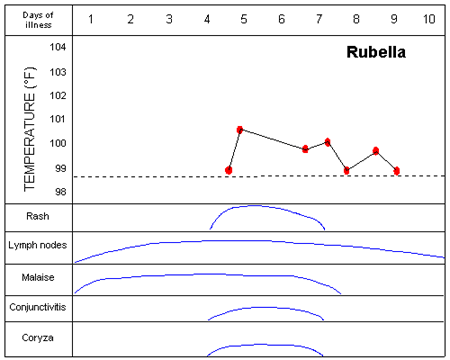
Figure 3
Scarlet fever
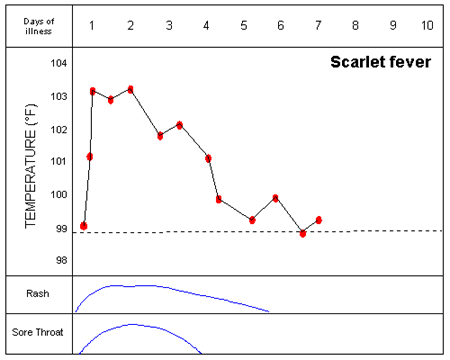
Figure 4
Dengue fever
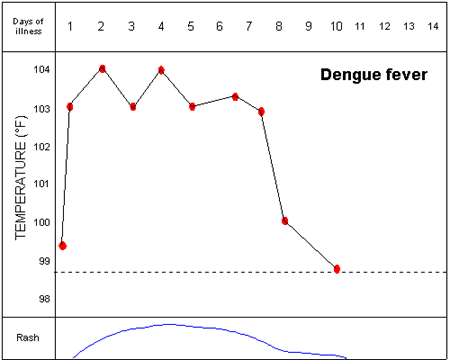
Figure 5
Exanthem Subitum (Roseola)
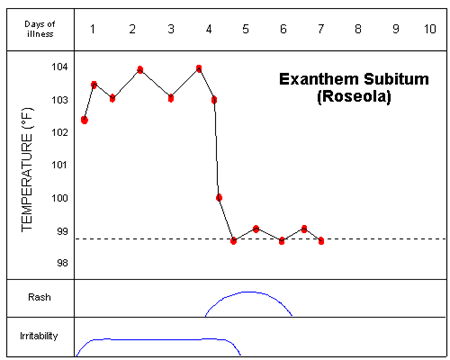
Figure 6
Chickenpox
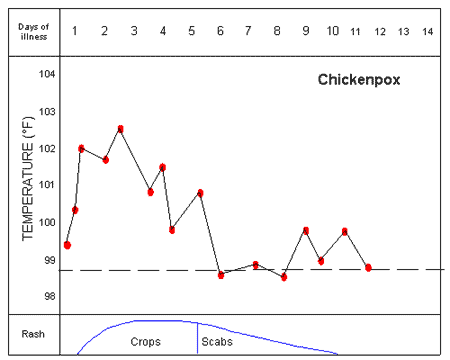
The above figures are reproduced with permission from Krugman S, Katz SL, Gershon AA, Wilfert CM. Infectious diseases of children. 9th ed. St. Louis, Missouri: Mosby Year Book Inc. 1992.
[Table of Contents]SPOTlight on
Research
Ratnam S, West R, Gadag V, Williams B, Oates E. Rubella Antibody Levels in School-Aged Children in Newfoundland: Implications for a Two-Dose Rubella Vaccination Strategy. Canadian Journal of Infectious Diseases 1997;8(2):85-88. (Reproduced by permission of The Canadian Journal of Infectious Diseases.)
A cross-sectional study was carried out to determine the levels of rubella immunity among school-aged children who received a single dose of measles-mumps-rubella (MMR) vaccine at 1 year of age.
A total of 1,053 children from the ages of 5 to 17 years (mean 10.5 years), representative of the Newfoundland provincial school population, were enrolled. All had received a single dose of documented MMR II vaccination at 1 year of age. Serum samples were tested for rubella IgG by enzyme immunoassay and a titre of > 10 IU was considered to indicate protective immunity.
A total of 145 children (13.8%) were considered rubella- susceptible with similar rates in males (13.6%) and females (13.8%). The rate of susceptibility ranged from 3.2% to 25.9% for different age groups with a significant increasing trend in older age groups. In the age group 8 to 17 years of age (15.5%) were susceptible versus 3.9% for the age group 5 to 8 years (X2=24.08: df=1, P < 0.001). The rate of decline in rubella titres was 8.1% per annum.
This study and others cited indicate that a substantial number of those who were given a single dose of MMR II vaccine may not have protective immunity against rubella as they reach prime reproductive age. The authors conclude that there is a definite need to consider a two-dose rubella vaccination strategy in Canada. In the move towards a routine two-dose measles vaccination in Canada, the MMR II vaccine* is being used for the second dose and given either at 18 months of age or at school entry. The impact of this timing of the second dose on long-term rubella immunity cannot be predicted at this time. The data also underscore the continuing need for prenatal rubella screening.
* Saskatchewan uses measles-rubella vaccine.
Measles: Enhanced Surveillance
System, Canada
Summary of Reported Cases (as of September 13, 1997)
Lucie BÈdard, Paul Varughese, Division of Immunization, Bureau of Infectious Diseases, LCDC, Ottawa
|
Province/Territory |
1996 |
1997 (January 1 to September 13) |
|||
|
Confirmed |
Clinical |
Suspected/Unknown |
Total |
||
| Newfoundland |
0 |
9 |
0 |
0 |
9 |
| Prince Edward Island |
0 |
0 |
0 |
0 |
0 |
| Nova Scotia |
4 |
1 |
0 |
0 |
1 |
| New Brunswick |
0 |
2 |
1 |
0 |
3 |
| Quebec |
83 |
2 |
0 |
0 |
2 |
| Ontario |
185 |
15 |
7 |
0 |
22 |
| Manitoba |
0 |
0 |
0 |
0 |
0 |
| Saskatchewan |
5 |
20 |
2 |
0 |
22 |
| Alberta |
8 |
185 |
60 |
0 |
245 |
| British Columbia |
40 |
146 |
127 |
29 |
302 |
| Yukon |
2 |
0 |
0 |
0 |
0 |
| Northwest Territories |
0 |
0 |
0 |
0 |
0 |
| Canada |
327 |
380 |
197 |
29 |
606 |
| Note: Data are provisional and are based on information available to LCDC at the time of tabulation. | |||||
Acknowledgements
The assistance and cooperation of all provincial and territorial epidemiologists and their staff, laboratory staff, medical officers of health and other health care personnel, and staff from LCDC is greatly appreciated.
[Table of Contents]Announcement
We are pleased to announce the publication of the first annual report on immunization achievements in Canada, the Canadian National Immunization Report, 1996, by the Division of Immunization, Bureau of Infectious Diseases, Laboratory Centre for Disease Control.
Copies of the report are available through the Canadian Medical Association. For additional information, please contact Dina Henderson, telephone (613) 731-8610 ext. 2028, facsimile (613) 731-9102. Price per copy is $15.00 (plus postage, handling and GST).
